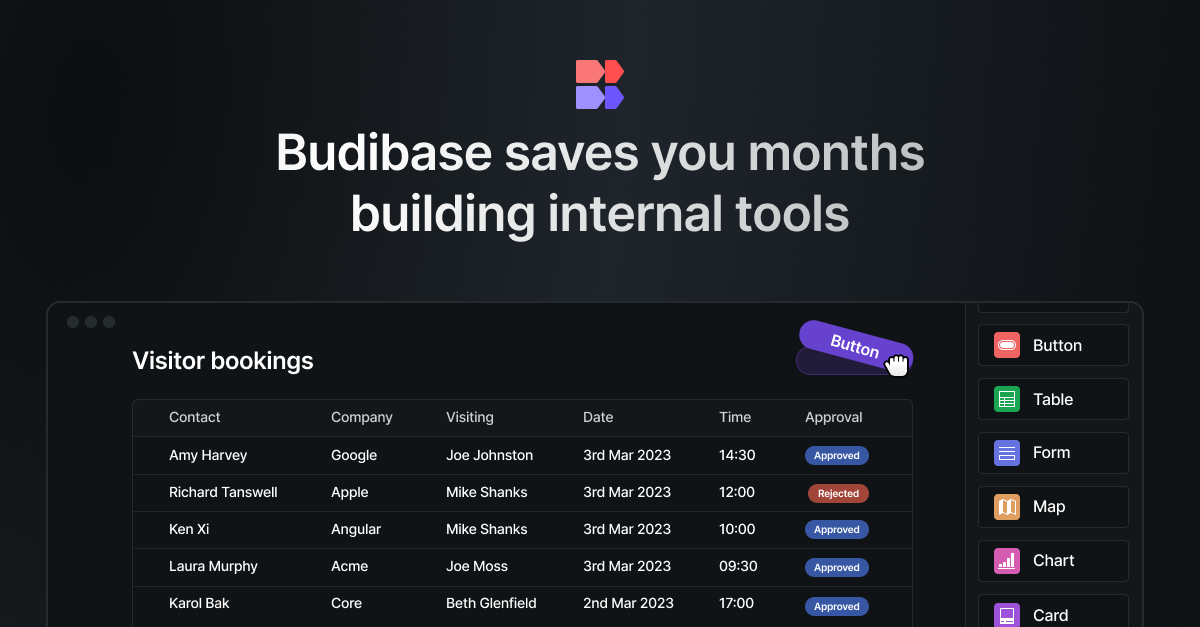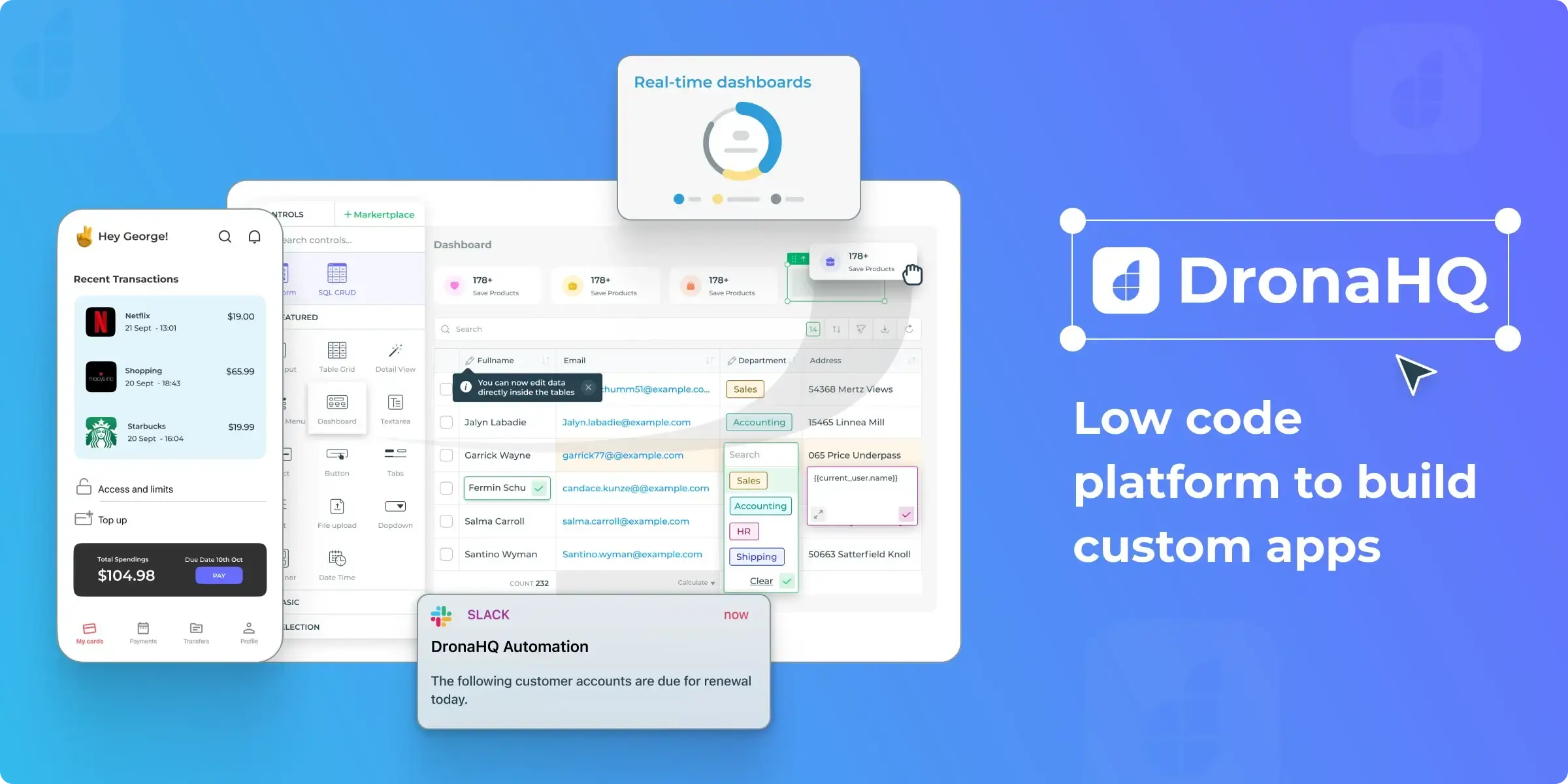The internal (or admin) tools are solutions that business teams use to streamline their processes and services. As a company that heavily relies on low-code platforms to develop custom internal tools, we know how effective they are.
They make your sales and customer service departments more productive, and your business becomes more transparent as a whole. Specifically, the introduction of internal tools at Akveo helped us revamp meetings management, data analytics, and many resource management activities.
Internal tools conundrum
From automating data management and Customer Relationship Management (CRM), to introducing robust business applications and revenue dashboards, the world of internal tools is vast. According to Retool’s report, about 55% of respondents state that they’re developing internal tools for their operational teams.

At the same time, when talking to CTOs, it’s not unusual to hear that their teams have way too many tasks and requests in the backlog. Sometimes ops teams wait for ages before their request goes into development. And that’s a bummer: the lack of internal tools considerably slows down business processes within the company. Considering the current downturn in the economy, this slowness (i.e unpreparedness) may come real costly for businesses that can’t adapt to the current economic situation.

According to Pipefy’s post, 40% of project managers believe that as much as half of internal processes can be automated using low code platforms. Platforms such as Retool and JetAdmin allow you to create internal applications and digital tools, while, say, Creatio helps you solve marketing and sales-related tasks. This way, if you employ people with some basic app development experience, such low-code solutions come in real handy.
Low-code/no-code difference
Here’s a little bit of theory before we plunge into details. What's the difference between low-code and no-code? Although you often see these two used interchangeably, it’s not quite so. To cut a long story short, low-code systems are suitable for complex and high-load tasks and require basic technical skills from users (so-called citizen developers).
No-code systems are the perfect match for solving simple tasks such as optimizing routine operations and creating unsophisticated systems for internal purposes. In the vast majority of cases, no-code platforms are provided only as cloud SaaS solutions. Plus, they also have large restrictions on the load and the number of allowed transactions, and high execution delays.
However, this segmentation is kind of relative. For instance, many no-code solutions require writing scripts for non-standard tasks. And some low-code tools provide functionality that can support complex processes without writing a single line of code.
The benefits of low-code
Let’s summarize the benefits of using low-code for businesses, shall we? First, more employees can be involved in development with low-code. In other words, DevOps teams no longer have to carry the burden of doing everything by themselves. Low-code platforms help:
- Accelerating problem-solving;
- Automating business workflows.
- Helping IT guys so they don’t have to manage (and code) myriads of requests;
- Drastically reducing application development costs;
- Ensuring business and sales teams get faster results.
These benefits are especially vital considering that business processes tend to change regardless of a company. Thus, you can say that business teams get more independent with low-code, and that’s the biggest benefit, I think. Nowadays, businesses require more and more applications, while developer services are becoming more and more expensive. So it’s no brainer to understand why the low-code movement is getting more popular day by day.

I don’t even mention that low-code development is often the only option available to small businesses. In turn, medium-sized businesses are attracted by the opportunity to develop an MVP (minimum viable product) in a short time and at minimal cost, launch it on the market, debug the unit-economy and eventually create a full-fledged product.
Large businesses usually resort to external low-code platforms for testing hypotheses, creating landing pages and internal corporate websites. Using low-code tools, qualified developers get more free time which they can spend on solving complex and important tasks.
Plus, automation. Low-code automates and optimizes routine processes and workflows with drag and drop features.
Upskilling
Another important thing to talk about is upskilling and professional development of the workforce. Today’s workers are looking for more opportunities to gain experience working with low-code or no-code platforms. More than 80% of users and potential users of low-code tools report that they would be more willing to work for a company that invests in their technical upskilling.
When you look at low-code, you see a range of platforms that might be easier or harder to use. The most common question we get from clients is “How can we develop a low-code strategy in a safe and manageable way?”
Well, talking about strategy, companies should concentrate on training citizen developers rather than hiring new expensive staff. It totally makes sense: employees are already familiar with other team members, the company's culture, goals, and business processes. In other words, it's easier for them to navigate in a familiar environment among friendly people they know.
Technical challenges in using low-code
Surely, low-code is not a silver bullet, and technical limitations exist. Let’s dive straight into the challenges of using low-code solutions. First of all, the low-code approach can’t solve the problem of increasing complexity that grows non-linearly while developing an IT solution. In the case of visual programming, the complexity grows too fast and the system may become unmanageable.
Secondly, you can build simple tools using low-code platforms, but what about complex ones? Sadly, there are problems that low-code platforms cannot solve in any way:
- Refactoring is either impossible or difficult. At the moment, no low-code platform has refactoring tools that come close to the level of advanced IDEs.
- Autotesting is impossible or extremely difficult. Without autotests, it becomes impossible to safely make changes, and the release of one feature requires a complete manual regression of the entire system. Certainly, that’s not something a reputable business needs.
- High loads, custom integrations, and security. These tasks require qualified engineers and cannot be completely solved by visual programming, which focuses on solving typical problems.
Another constraint is security issues and requirements for the protection of personal data. What information are you willing (or entitled) to entrust to a third-party platform? Low-code or not, you still need developers to organize data storage and develop security systems.
No wonder that many organizations rely on 3rd party low-code consultants and developers in their digital journey. However, low-code can’t compete (or let alone replace) with classical development, and both approaches just complement each other. The secret of success lies in choosing the right tool (and the right team) for solving a specific business problem.
To wrap up
Currently, the most popular internal tool builders in the market are Retool, Internal.io, Bubble Appsmith, UI Bakery, and JetAdmin. Such low-code systems help businesses lower their dependence on expensive developers, cut costs, and accelerate digital transformation.
Fair enough, challenges exist. However, the low-code approach remains a major trend for developing innovative solutions for enterprises and startups. As low-code advocates, we provide low-code related services, from consultations to development itself. Contact us to discuss how we can accelerate low-code-powered digital transformation for your business.
P.S. We love writing about low-code. Consider subscribing to our blog to get the latest industry insight in your inbox.
P.P.S. The graphs in this article are taken from this source.
Streamlining Gifting Marketplace Operations with Retool
Afloat, a gifting marketplace, needed custom dashboards to streamline order management, delivery tracking, and reporting while integrating with Shopify and external APIs.
The solution:
We built two Retool-based dashboards:
- A Retail Partner Dashboard embedded into Shopify for managing orders and store performance.
- An Admin Dashboard for handling deliveries and partner data.
Both dashboards included real-time integration with Afloat's Backend and APIs for accurate, up-to-date data and scalability.
The result: enhanced efficiency, error-free real-time data, and scalable dashboards for high-order volumes.
Billing Automation for a SaaS Company with Low-Code
Our client needed a robust billing solution to manage hierarchical licenses, ensure compliance, and automate invoicing for streamlined operations.
The solution:
We developed a Retool-based application that supports multi-tiered licenses, automates invoicing workflows, and integrates seamlessly with CRM and accounting platforms to enhance financial data management.
The result:
- Achieved 100% adherence to licensing agreements, mitigating penalties.
- Automated invoicing and workflows reduced manual effort significantly.
- Dashboards and reports improved decision-making and operational visibility.
Retool Dashboards with HubSpot Integration
Our client needed a centralized tool to aggregate account and contact activity, improving visibility and decision-making for the sales team.
The solution
We built a Retool application integrated with HubSpot, QuickMail, and Clay.com. The app features dashboards for sorting, filtering, and detailed views of companies, contacts, and deals, along with real-time notifications and bidirectional data syncing.
The result
- MVP in 50 hours: Delivered a functional application in just 50 hours.
- Smarter decisions: Enabled data-driven insights for strategic planning.
- Streamlined operations: Reduced manual tasks with automation and real-time updates.
Lead Generation Tool to Reduce Manual Work
Our client, Afore Capital, a venture capital firm focused on pre-seed investments, aimed to automate their lead generation processes but struggled with existing out-of-the-box solutions. To tackle this challenge, they sought assistance from our team of Akveo Retool experts.
The scope of work
The client needed a tailored solution to log and track inbound deals effectively. They required an application that could facilitate the addition, viewing, and editing of company and founder information, ensuring data integrity and preventing duplicates. Additionally, Afore Capital aimed to integrate external tools like PhantomBuster and LinkedIn to streamline data collection.
The result
By developing a custom Retool application, we streamlined the lead generation process, significantly reducing manual data entry. The application enabled employees to manage inbound deals efficiently while automated workflows for email parsing, notifications, and dynamic reporting enhanced operational efficiency. This allowed Afore Capital's team to focus more on building relationships with potential founders rather than on administrative tasks.
Retool CMS Application for EdTech Startup
Our client, CutTime, a leading fine arts education management platform, needed a scalable CMS application to improve vendor product management and user experience.
The scope of work
We developed a Retool application that allows vendors to easily upload and manage product listings, handle inventory, and set shipping options. The challenge was to integrate the app with the client’s system, enabling smooth authentication and product management for program directors.
The result
Our solution streamlined product management, reducing manual work for vendors, and significantly improving operational efficiency.
Building Reconciliation Tool for e-commerce company
Our client was in need of streamlining and simplifying its monthly accounting reconciliation process – preferably automatically. But with a lack of time and low budget for a custom build, development of a comprehensive software wasn’t in the picture. After going through the case and customer’s needs, we decided to implement Retool. And that was the right choice.
The scope of work
Our team developed a custom reconciliation tool designed specifically for the needs of high-volume transaction environments. It automated the processes and provided a comprehensive dashboard for monitoring discrepancies and anomalies in real-time.
The implementation of Retool significantly reduced manual effort, as well as fostered a more efficient and time-saving reconciliation process.
Creating Retool Mobile App for a Wine Seller
A leading spirits and wine seller in Europe required the development of an internal mobile app for private client managers and administrators. The project was supposed to be done in 1,5 months. Considering urgency and the scope of work, our developers decided to use Retool for swift and effective development.
The scope of work
Our developers built a mobile application tailored to the needs of the company's sales force: with a comprehensive overview of client interactions, facilitated order processing, and enabled access to sales history and performance metrics. It was user-friendly, with real-time updates, seamlessly integrated with existing customer databases.
The result? Increase in productivity of the sales team and improved decision-making process. But most importantly, positive feedback from the customers themselves.
Developing PoC with Low Code for a Tour Operator
To efficiently gather, centralize, and manage data is a challenge for any tour operator. Our client was not an exception. The company was seeking to get an internal software that will source information from third-party APIs and automate the travel itinerary creation process. Preferably, cost- and user-friendly tool.
The scope of work
Our experts ensured the client that all the requirements could be covered by Retool. And just in 40 hours a new software was launched. The tool had a flexible and easy-to-use interface with user authentication and an access management system panel – all the company needed. At the end, Retool was considered the main tool to replace the existing system.
Testing New Generation of Lead Management Tool with Retool
Our client, a venture fund, had challenges with managing lead generation and client acquisition. As the company grew, it aimed to attract more clients and scale faster, as well as automate the processes to save time, improve efficiency and minimize human error. The idea was to craft an internal lead generation tool that will cover all the needs. We’ve agreed that Retool will be a perfect tool for this.
The scope of work
The project initially began as a proof of concept, but soon enough, with each new feature delivered, the company experienced increased engagement and value.
We developed a web tool that integrates seamlessly with Phantombuster for data extraction and LinkedIn for social outreach. Now, the company has a platform that elevates the efficiency of their lead generation activities and provides deep insights into potential client bases.
Building an Advanced Admin Portal for Streamlined Operations
Confronted with the need for more sophisticated internal tools, an owner of IP Licensing marketplace turned to Retool to utilize its administrative functions. The primary goal was to construct an advanced admin portal that could support complex, multi-layered processes efficiently.
The scope of work
Our client needed help with updating filters and tables for its internal platform. In just 30 hours we've been able to update and create about 6 pages. Following features were introduced: add complex filtering and search, delete records, styling application with custom CSS.
Together, we have increased performance on most heavy pages and fixed circular dependency issues.
Creating MVP Dashboard for Google Cloud Users
Facing the challenge of unoptimized cloud resource management, a technology firm working with Google Cloud users was looking for a solution to make its operations more efficient. The main idea of the project was to create an MVP for e-commerce shops to test some client hypotheses. Traditional cloud management tools fell short.
The scope of work
Determined to break through limitations, our team of developers turned Retool. We decided to craft an MVP Dashboard specifically for Google Cloud users. This wasn't just about bringing data into view; but about reshaping how teams interact with their cloud environment.
We designed a dashboard that turned complex cloud data into a clear, strategic asset thanks to comprehensive analytics, tailored metrics, and an intuitive interface, that Retool provides. As the results, an increase in operational efficiency, significant improvement in cost management and resource optimization.
Elevating CRM with Custom HubSpot Sales Dashboard
Our other client, a SaaS startup, that offers collaborative tools for design and engineering teams, was on a quest to supercharge their sales efforts. Traditional CRM systems were limited and not customizable enough. The company sought a solution that could tailor HubSpot to their workflow and analytics needs.
The scope of work
Charged with the task of going beyond standard CRM functions, our team turned to Retool. We wanted to redefine how sales teams interact with their CRM.
By integrating advanced analytics, custom metrics, and a user-friendly interface, our developers provided a solution that transformed data into a strategic asset.
In 40 hours, three informative dashboards were developed, containing the most sensitive data related to sales activities. These dashboards enable our customer to analyze sales and lead generation performance from a different perspective and establish the appropriate KPIs.
Building a PDF Editor with Low-Code
Our client, a leading digital credential IT startup, needed a lot of internal processes to be optimized. But the experience with low-code tools wasn’t sufficient. That’s why the company decided to hire professionals. And our team of developers joined the project.
The scope of work
The client has a program that designs and prints custom badges for customers. The badges need to be “mail-merged” with a person’s info and turned into a PDF to print. But what is the best way to do it?
Our developers decided to use Retool as a core tool. Using custom components and JavaScript, we developed a program that reduced employees' time for designing, putting the data, verifying, and printing PDF badges in one application.
As a result, the new approach significantly reduces the time required by the internal team to organize all the necessary staff for the conference, including badge creation.




















